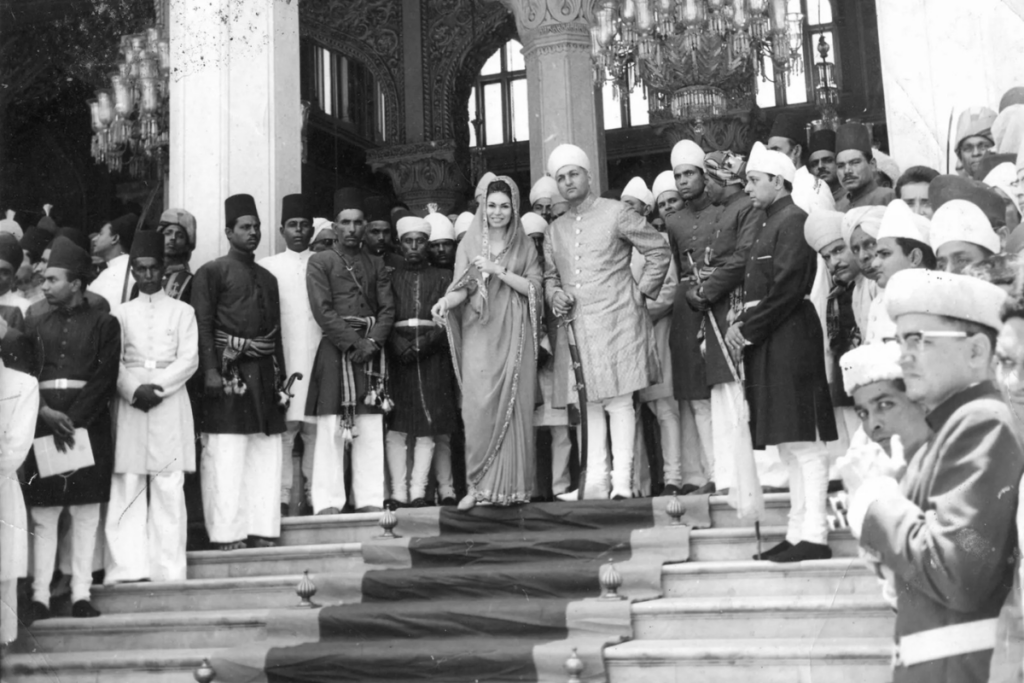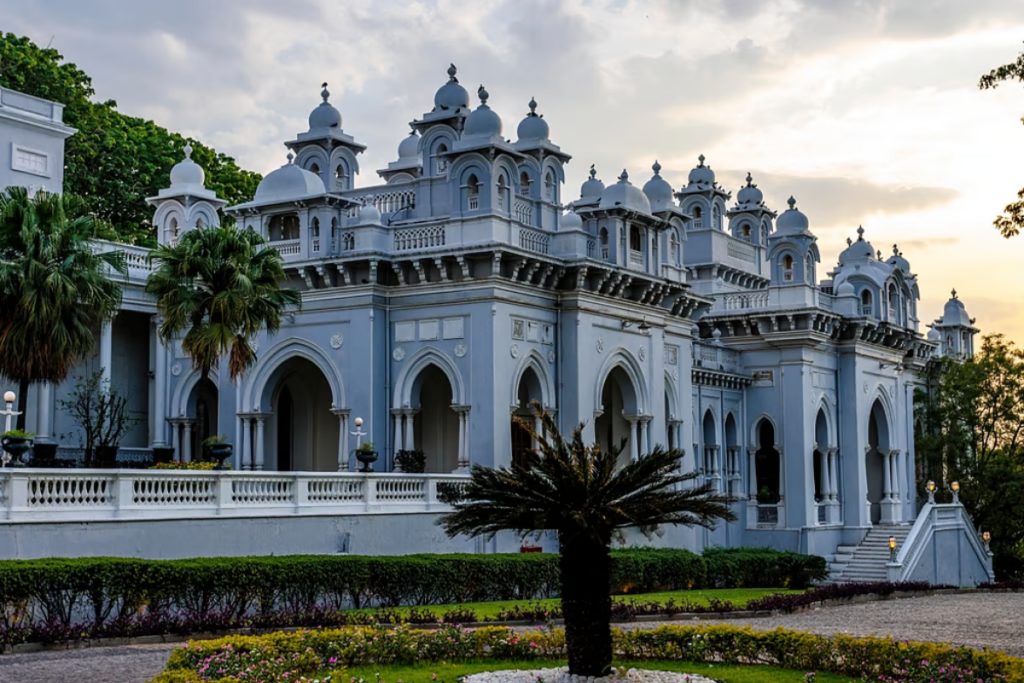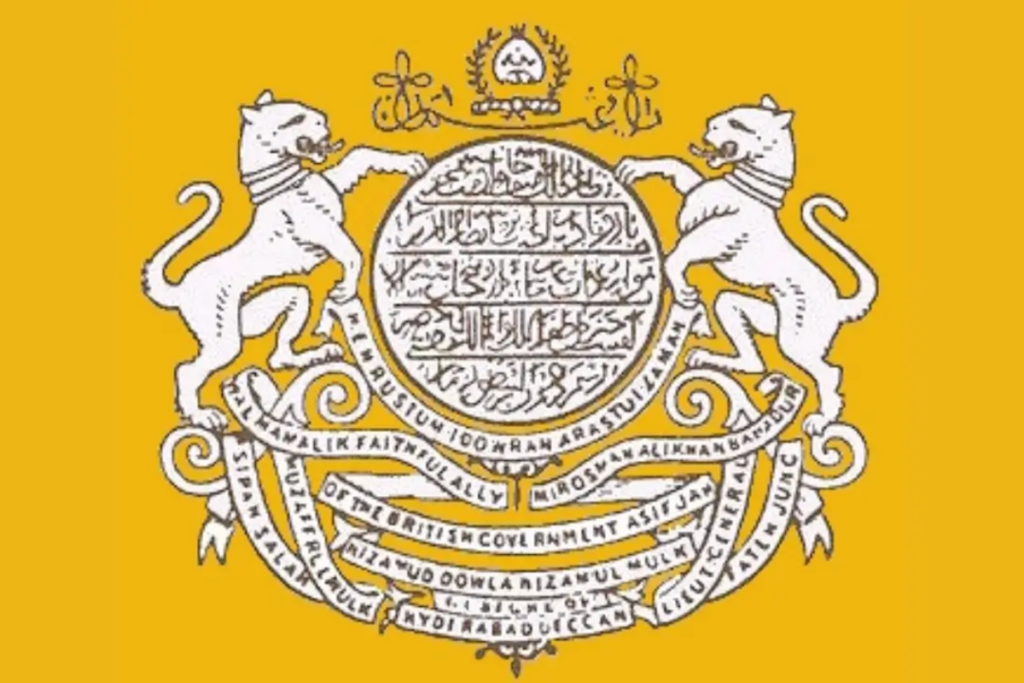
Quick Summary
Table of Contents
The Nizam of Hyderabad was a title given to the rulers of the Hyderabad State in India from the 18th century until 1948. It wasn’t a single person but the Asaf Jahi dynasty. Mir Qamar-ud-Din Siddiqi founded it, and they ruled the state of Hyderabad from 1724 to 1948.
The Nizams were powerful rulers controlling a large and wealthy state in central India. The last Nizam, Mir Osman Ali Khan, was considered one of the richest people in the world at his time. Their governance molded contemporary Telangana’s culture, arts, socio-economic standing, and educational landscape.

The table below details the seven Nizams of Hyderabad, their reigns, and key events from their respective periods.
| Nizam | Period | Notable Facts |
|---|---|---|
| Asaf Jah I (Mir Qamar-ud-Din Siddiqi) | 1724–1748 | Founded the independent monarchy of Hyderabad after serving as a Mughal Viceroy. Established the Asaf Jahi dynasty, which would rule Hyderabad for centuries. Strengthened the administration, military, and cultural institutions. |
| Asaf Jah II (Mir Nizam Ali Khan) | 1762–1803 | Faced military losses and became a tributary of the Maratha Confederacy. Struggled to maintain control over the Deccan region. Encouraged art, literature, and architecture during his reign. |
| Asaf Jah III (Mir Akbar Ali Khan) | 1803–1829 | Witnessed the British alliance against the Marathas. Signed the Subsidiary Alliance with the British East India Company. Supported educational reforms and patronized scholars. |
| Asaf Jah IV (Mir Tahniat Ali Khan) | 1829–1857 | Ruled during the First War of Indian Independence (1857). Faced financial challenges due to the costly wars. Promoted Urdu literature and cultural revival. |
| Asaf Jah V (Mir Afzal-ud-Din Ali Khan) | 1857–1869 | Oversaw educational advancements and infrastructure development. Encouraged industrial growth and established Osmania University. His reign witnessed the Great Musi Flood of 1908. |
| Asaf Jah VI (Mir Mahbub Ali Pasha) | 1869–1911 | Oversaw educational advancements and infrastructure development. Encouraged industrial growth and established Osmania University. His reign witnessed the Great Musi Flood of 1908. |
| Asaf Jah VII (Mir Osman Ali Khan) | 1911–1948 | The last Nizam, India, annexed Hyderabad State in 1948. Known for his immense wealth, including the Jacob Diamond and the Nizam’s Sikkah. His rule saw significant socio-economic changes and political challenges. |
Nizam of Hyderabad in 1947, India gained independence from British rule. This was a big year for the entire country, and the state of Hyderabad, ruled by the Nizam, was no exception.
Mir Osman Ali Khan, the 7th and last Nizam of Hyderabad, inherited a dynasty known for its vast wealth and influence. Under his rule, Hyderabad was among the richest princely states in British India, thanks to its fertile lands, strategic trade routes, and natural resources like the famous Golconda diamond mines. In 1937, Time magazine declared him the richest man in the world. His fortune included the Jacob Diamond, used as a paperweight, and a vast collection of jewels now known as the Jewels of the Nizams.
When India gained independence in 1947, the princely states could accede to India or Pakistan or remain independent. While most states chose to join India, Mir Osman Ali Khan was reluctant. He ruled over a culturally diverse population and faced complex internal politics. His hesitation placed Hyderabad in a politically sensitive spot during a time of national upheaval.
Mir Osman Ali Khan’s legacy is complex. He was a rich and powerful ruler who oversaw a time of growth for Hyderabad. However, his hesitation during India’s independence led to uncertainty for his state.
Mir Osman Ali Khan aspired to maintain Hyderabad as an independent dominion, separate from both India and Pakistan. He envisioned Hyderabad as a member of the British Commonwealth, similar to Canada or Australia, where the British monarch remained a symbolic head of state. This was an ambitious and controversial idea, considering Hyderabad’s geographical location in the heart of India, and its dependence on the Indian mainland for trade and communication.
The Nizam’s refusal to join India led to growing unrest within the state. Many people of Hyderabad wanted to integrate with India, and tensions rose between pro-independence forces and pro-India groups. The state also faced issues with internal rebellion, notably from the Razakars, a paramilitary group loyal to the Nizam that clashed with civilian populations and Indian interests, further escalating the crisis.
In September 1948, the Government of India launched “Operation Polo”, a swift military operation to annex Hyderabad into the Indian Union. The operation lasted just five days, ending in the Nizam’s surrender and the state’s formal accession to India. Though his political authority ended, Mir Osman Ali Khan remained a respected and wealthy private citizen, and he was even appointed Rajpramukh (constitutional head) of Hyderabad State for a few years afterward. His legacy remains deeply embedded in the cultural and historical identity of Hyderabad.
The Nizam of Hyderabad played a crucial role in shaping the history and culture of South India. As the ruler of one of the wealthiest and most potent princely states in British India, the Nizam of Hyderabad was known for his patronage of arts, architecture, and education. His influence extended far beyond politics, with the Nizam of Hyderabad fostering a legacy that continues to impact the region today. From his lavish lifestyle to his contributions to Hyderabad’s development, Nizam’s legacy remains integral to the city’s identity.

The Nizam of Hyderabad fostered a vibrant culture that blended Persian, Mughal, and Deccan traditions. Under the rule of the Nizam of Hyderabad, the region saw remarkable advancements in arts, architecture, and literature, with the Nizam promoting the construction of grand palaces, mosques, and educational institutions. The Nizam of Hyderabad also supported the flourishing of classical music, dance, and literature, making the state a cultural hub of India. This legacy of artistic patronage and cultural development continues to define the heritage of Hyderabad today. Nizam’s Legacy: Art, Architecture, and Culture
Imagine kings who ruled Hyderabad, India, for over 200 years! These weren’t your average rulers the Nizams were super rich and left behind a sparkling legacy of fantastic art, awesome buildings, and cool traditions that Hyderabad is famous for today.


While Mir Osman Ali Khan, the last Nizam of Hyderabad, wasn’t known for founding specific organizations in the traditional sense, he did play a significant role in establishing and supporting various public institutions within Hyderabad state. Here’s a breakdown:
Nizam’s focus wasn’t on creating private organizations but on building public infrastructure and institutions for the benefit of his people. This included:
He also played a role in:
The Hyderabad Nizams’ family tree is a tapestry of ancestry and genealogy that transcends generations. The dynasty’s roots may be traced back to Mir Qamar-ud-din Siddiqi, the 1st Nizam of Hyderabad. Each tree branch depicts an age, an epoch in which rulers rose and fell, determining Hyderabad’s destiny.
The Nizam dynasty’s family relations and dynastic connections were extensive, deeply influencing their political and social standing. The Nizam of Hyderabad strategically formed alliances and unions with other royal houses and noble families through intermarriages, strengthening their political and diplomatic ties. These connections significantly enhanced the power and reputation of the Nizam of Hyderabad, making the dynasty a formidable force in Indian history.
The family tree of the Nizam of Hyderabad reveals fascinating stories of personal affection, loyalty, and contest, showcasing the complexities of their rule and legacy.
The Nizam of Hyderabad reflects the majesty and complexities of the city’s history, from its renowned founder Mir Siddiqi to its final ruler, Mir Osman Ali Khan. The Nizam of Hyderabad family tree unfolds a rich tapestry of connections, power struggles, and regal splendor, showcasing the dynasty’s influence. Through their reign, the Nizam of Hyderabad left an indelible mark on India’s past, embodying a legacy of grandeur and significance.
In the present period, the Hyderabad Nizam family now lives a more private life with less governmental power. They retain symbolic value as stewards of their cultural heritage and legacy. While their direct political power has waned, their historical significance remains a source of admiration and fascination.
The legacy of the Hyderabad last Nizam lives on through the continued efforts of the Nizam family, who remain active in humanitarian causes, education, and cultural preservation. Today, descendants of the royal lineage are dedicated to promoting art, literature, and the safeguarding of historical sites that reflect their storied past. Several family members have embraced roles in public philanthropy and social welfare, showcasing a commitment to upholding the values instilled by their ancestors. This ongoing involvement not only honors the memory of the Hyderabad last Nizam but also strengthens the city’s cultural and social fabric.
| Nizam | Reign | Father | Successor | Spouse(s) |
|---|---|---|---|---|
| Asaf Jah I (Mir Qamar-ud-Din Siddiqi) | 1724–1748 | Ghazi-ud-Din Khan | Asaf Jah II (Nizam Ali Khan) | Multiple wives |
| Asaf Jah II (Nizam Ali Khan) | 1762–1803 | Asaf Jah I | Asaf Jah III (Sikandar Jah) | Azmat un-Nisa Begum, others |
| Asaf Jah III (Sikandar Jah) | 1803–1829 | Asaf Jah II | Asaf Jah IV (Nasir-ud-Daulah) | Multiple wives |
| Asaf Jah IV (Nasir-ud-Daulah) | 1829–1857 | Asaf Jah III | Asaf Jah V (Afzal-ud-Daulah) | Multiple wives |
| Asaf Jah V (Afzal-ud-Daulah) | 1857–1869 | Asaf Jah IV | Asaf Jah VI (Mahbub Ali Pasha) | Amat-uz-Zehra Begum, others |
| Asaf Jah VI (Mahbub Ali Pasha) | 1869–1911 | Asaf Jah V | Asaf Jah VII (Mir Osman Ali Khan) | Amat-uz-Zehra Begum, others |
| Asaf Jah VII (Mir Osman Ali Khan) | 1911–1948 | Asaf Jah VI | Monarchy abolished (Hyderabad merged with India in 1948) | Dulhan Pasha Begum, others |
The enduring impact of the Nizams has left an unmistakable stamp on Hyderabad’s identity. Their reign charmed the city’s architectural, cultural landscape, and socioeconomic fabric. Charminar, Golconda Fort, and Falaknuma Palace are examples of their architectural prowess. The Nizams’ support for the arts, writing, and education helped to enrich the city’s cultural fabric.
The Nizam of Hyderabad lives on in the city’s collective imagination, celebrated through festivals, museums, and historical sites. Their progressive ideas, charitable efforts, and focus on education remain influential. The Nizam of Hyderabad blended Persianate and indigenous influences, captivating researchers, tourists, and locals alike. Their enduring legacy is a source of pride, bridging Hyderabad’s past and present with cultural and historical significance.
The Nizam Empire was more than just a princely rule—it symbolized grandeur, sophistication, and strategic power in Indian history. Spanning over two centuries, the legacy of the Nizam of Hyderabad continues to echo through the rich heritage of Telangana and beyond. With unmatched wealth, political influence, and cultural patronage, the Nizam Empire stood as a beacon of opulence and governance.
Their contributions to art, education, infrastructure, and architecture helped transform Hyderabad into a vibrant and modern city. From iconic structures like the Falaknuma Palace and Mecca Masjid to the foundations of institutions like Osmania University and the State Bank of Hyderabad, the Nizam Empire left an indelible mark on India’s landscape.
Though the monarchy ended in 1948, the legacy of the Nizam Empire remains deeply woven into Hyderabad’s identity. It is remembered not only for its historical significance but also for its enduring cultural and architectural treasures, which continue to inspire awe and admiration.
As the current head of the House of Asaf Jah, Nizam Mir Muhammad Azmet Ali Khan, Asaf Jah IX, also known as Azmet Jah (also spelled Azmat Jah; born July 23, 1960), claims the title of Nizam of Hyderabad and Berar as of January 20, 2023, although the Indian government has not recognized such titles since 1971.
Hyderabad prospered throughout the Nizams’ reign because of the Golconda mines, which at the time were the only sources of diamonds available on the global market (apart from South African mines). This made the 7th Nizam the richest person in the world.
Since 1719, the native sovereigns of Hyderabad State, India, have gone by the title of Nizam. They were members of the Jahi dynasty, Asaf. Mir Qamar-ud-Din Siddiqi, a viceroy of the Deccan under the Mughal emperors from 1713 until 1721, established the dynasty.
In the 1930s, Osman Ai Khan, the final Nizam, was the richest person on the planet. His riches were derived from the taxes that farmers paid.
Yes, the Nizam family still exists. The current titular Nizam is Mir Azmet Ali Khan and Raunaq Yar Khan. Both are vying for control over palaces, jewelry, and land deeds, even though the title itself holds no power in independent India.
The Falaknuma Palace, once owned by the Nizams of Hyderabad, now belongs to the Taj Group of Hotels Resorts and Palaces.
Mir Osman Ali Khan’s net worth, adjusted for today’s inflation, is estimated to have been around $230 billion (approximately Rs 17.47 lakh crore). His fortune included 100 million pounds of gold and 400 million pounds worth of other jewels.
Today, however, one branch of the Nizam’s family — the descendants of the first to the sixth Nizam — have none of the airs of a rich heir. They live in Hyderabad doing odd jobs and running small businesses.
The Indian government largely seized the wealth of the Nizam of Hyderabad after Hyderabad’s merger with India in 1948. His assets, including gold, jewelry, and estates, were confiscated, with some portions liquidated for reconstruction purposes.

Authored by, Amay Mathur | Senior Editor




Amay Mathur is a business news reporter at Chegg.com. He previously worked for PCMag, Business Insider, The Messenger, and ZDNET as a reporter and copyeditor. His areas of coverage encompass tech, business, strategy, finance, and even space. He is a Columbia University graduate.
Editor's Recommendations
Chegg India does not ask for money to offer any opportunity with the company. We request you to be vigilant before sharing your personal and financial information with any third party. Beware of fraudulent activities claiming affiliation with our company and promising monetary rewards or benefits. Chegg India shall not be responsible for any losses resulting from such activities.
Chegg India does not ask for money to offer any opportunity with the company. We request you to be vigilant before sharing your personal and financial information with any third party. Beware of fraudulent activities claiming affiliation with our company and promising monetary rewards or benefits. Chegg India shall not be responsible for any losses resulting from such activities.